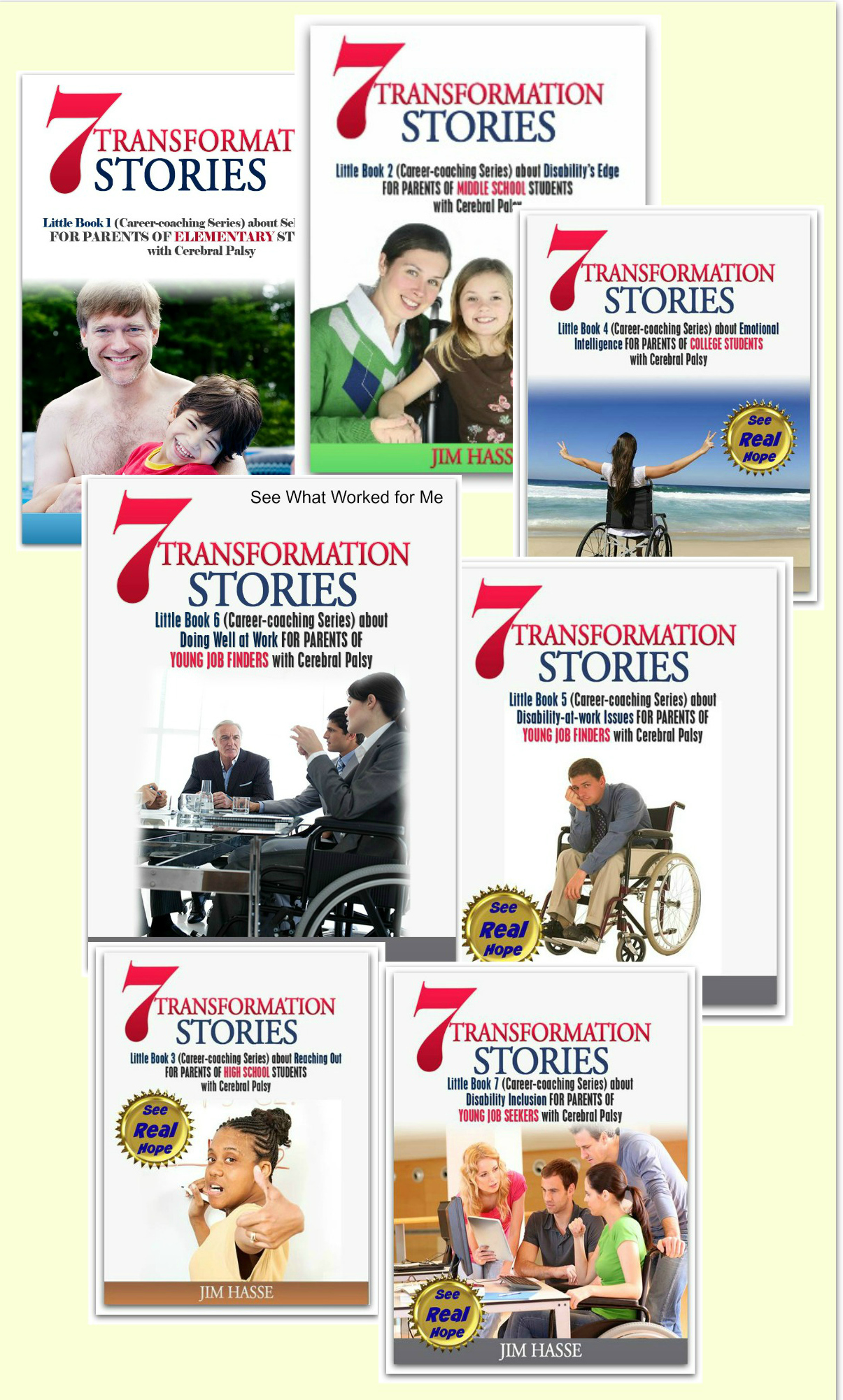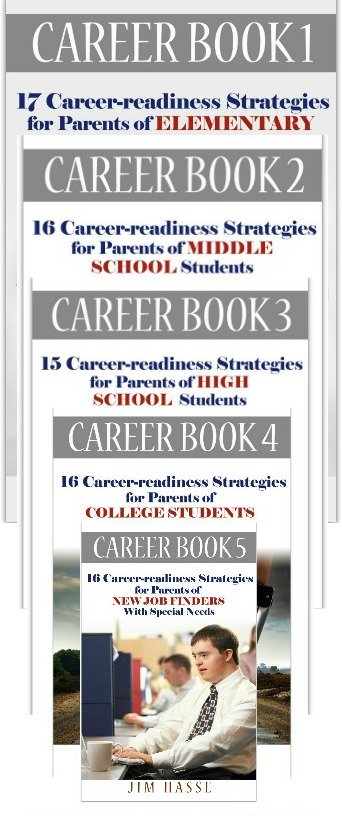Goal Setting for Adults: Your Job Seeker's Cerebral Palsy Career Builder
By Jim Hasse, ABC, GCDF, Disability Employment Expert
_________________________________________________________
Goal setting for adults is all about learning how to work less and, at same time, do more.
In fact, knowing how to work less but do more can be a career builder for your mature son or daughter who has cerebral palsy (CP) and is now entering the job market. It can help him or her get hired. Let me explain.
Yes, job seeking is a full-time job. But, no, it does not have to consume the life of your son or daughter who is making the transition from school to work. Gaining that balance is knowing about goal setting for adults.
In fact, learning how to work less and still get more done than competitors for a particular job before working full-time is a valuable skill your son or daughter can highlight in the bundle of personal attributes he or she markets to prospective employers.
Those who are productive in their job searches are likely to be productive on the job. Employers are well aware of that fact. It all comes down to goal setting for adults.
And, knowing how to effectively manage personal time may be even more important for your youngster with CP. Prospective hiring managers, after all, probably wonder in their heads whether, as a result of CP, your son or daughter will be able “to carry their share of the load” within a work setting.

Goal setting for adults: Work less, do more
That’s why I’m particularly impressed with what Stever Robbins, a recognized time management expert and executive, has to say about maximizing productivity on the job without sacrificing one's personal life.
He’s a graduate of Harvard Business School and MIT. His newest book is “Get-It-Done Guy’s Nine Steps to Work Less and Do More.”
I like Robbins’ basic premise about productivity. He believes putting in eight hours of work a day is irrelevant (particularly for the person who is self-employed). What counts is working on activities which have the most impact on achieving one's most important goals. He recommends spending time on what will move a project forward toward those goals. Again -- a mature approach to goal setting for adults.
Robbins says goal setting for adults needs to give direction to one's life. Goals can help your son or daughter develop the kind of life he or she wants.
So, he recommends, “First, decide how you want to spend your time --- and then set goals which control your time and which will help you achieve that kind of life.”
For instance, at 74, I want to build a balanced retirement in which I continue to:
- Learn about disability in our society.
- Contribute to mutual understanding about disability in both the abled and disabled worlds.
- Cultivate relationships with my wife, family, friends and colleagues; enjoy leisurely car trips in exploring North America; and tap into new learning opportunities on the university campus where we live.
To gain that balance, my goal is to spend two hours a day at my computer (managing www.cerebral-palsy-career-builders.com to pass on career, business and marketing tips I’ve learned -- and wish I had 40 years ago -- to others).
That covers the first two points above that I thoroughly enjoy. Then, I want to devote the remainder of my time on point number 3, my free time for exploring other interests.
My dream is a life with continued growth and challenge without heavy deadlines.
Goal setting for adults: Nine productivity steps
In his book, “Get-It-Done Guy’s Nine Steps to Work Less and Do More,” Robbins gives a broad range of quick tips for managing time effectively. I’d like to share a few of them with you that I find refreshing and that you may want to pass on to your job seeker with CP. I’ll do that in the context of his nine productivity steps.
His nine steps to working less and doing more are:
- Live on purpose. Live the life you want. Write down your primary goals and review them regularly out loud (daily). Then, as you go about your work, ask yourself, “Why am I doing this task?”
- Stop procrastination. Make a commitment to other people (perhaps through a mastermind group) to get work done and then set aside “action days” to do it.
- Conquer technology. Technology today increases our productivity, but it can also be a burden because it gets in the way sometimes of getting things done. Technology doesn’t always make our lives better. It can be a time waster and a distraction. So, do a “technology audit” by writing down what you use and how it helps you with your purpose.
- Stop distractions. Staying focused is difficult today. Your computer is a tool, not a “place.” Put a “to do” sticky note on your computer screen, complete those tasks and then take the note off. That frees you to do other non-computer tasks.
- Optimize. Examine the ways you get things done every four to six months. How can you complete a task with the least time and effort?
- Stay organized. “Messy” is not always bad, if you can find what you need, but searching for something and not being able to find it is a time waster. Everything needs a place. Before you clean your desk, categorize your “stuff” first on paper and then move things that are on your list.
- Stop wasting time. Don’t try to open and answer every e-mail, for instance. Getting your e-mail inbox to zero is a time waster.
- Build stronger relationships. Most of business today is based on relationships. With effective relationships, you can ask for favors, get a little slack, make and receive more referrals, and have more reach.
- Leverage. Look for ways to multiply your results without more time on your part through delegation, subcontracting, repurposing etc. Do what you do best and arrange for others to help you with tasks that are not in your top-skill range. Make rules for the decisions you need to make on a routine basis so you don’t have to consider every option every time (such as deciding which e-mail to open).
Robbins defines productivity as how much work it takes to get the results you want from your job and to live your life to the fullest. He says that means sometimes you need to say “no” to someone who is seeking a portion of your time.
I wish I had these bits of advice 50 years ago. I was 24 and needed advice about goal setting for adults.
The key concept in goal setting for adults is that one is in charge of his or her life. Your son or daughter needs to decide how he or she will use personal time (and let no one else make that decision).
In doing so, your young job seeker will be able to answer, in concrete terms, the often-unasked question in job interviews: “With your disability, how do you intend to carry your share of the weight in this job?”
Return from Goal Setting for Adults to Job Finder
Go to Cerebral Palsy Career Builders
This is Creative Commons content. You can freely and legally use, share and repurpose it for non-commercial purposes only, provided you attach this sentence and the following attribution to it (including the two links):
Originally written and illustrated by Jim Hasse, ABC, GCDF, owner of Hasse Communication Counseling, LLC, who, as a person with cerebral palsy, served for 10 years as a vice president in a Fortune 500 company during his 29-year career in corporate communication. He’s an Accredited Business Communicator, certified as a Global Career Development Facilitator and author of 14 Amazon books about disability awareness and disability employment issues.





